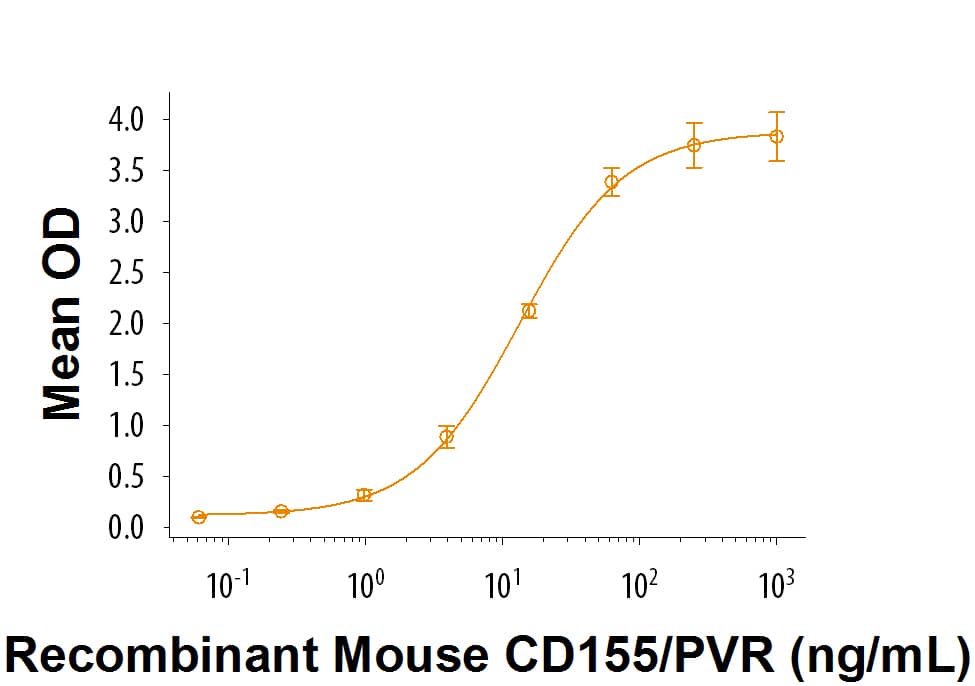Recombinant Mouse CD155/PVR Fc Chimera Protein, CF
R&D Systems, part of Bio-Techne | Catalog # 9670-CD

Key Product Details
Source
NS0
Accession #
Structure / Form
DIsulfide-linked homodimer
Conjugate
Unconjugated
Applications
Bioactivity
Product Specifications
Source
Mouse myeloma cell line, NS0-derived mouse CD155/PVR protein
| Mouse CD155/PVR (Asp29-Leu348) Accession # NP_081790 |
IEGRMDP | Mouse IgG2a (Glu98-Lys330) |
| N-terminus | C-terminus |
Purity
>90%, by SDS-PAGE visualized with Silver Staining and quantitative densitometry by Coomassie® Blue Staining.
Endotoxin Level
<0.10 EU per 1 μg of the protein by the LAL method.
N-terminal Sequence Analysis
Asp29
Predicted Molecular Mass
62 kDa
SDS-PAGE
92-108 kDa, reducing conditions
Activity
Measured by its binding ability in a functional ELISA.
When Recombinant Mouse CD96 (Catalog # 5690-CD) is coated at 1 μg/mL (100 μL/well), the concentration of Recombinant Mouse CD155/PVR Fc Chimera that produces 50% optimal binding response is 6-36 ng/mL.
When Recombinant Mouse CD96 (Catalog # 5690-CD) is coated at 1 μg/mL (100 μL/well), the concentration of Recombinant Mouse CD155/PVR Fc Chimera that produces 50% optimal binding response is 6-36 ng/mL.
Scientific Data Images for Recombinant Mouse CD155/PVR Fc Chimera Protein, CF
Recombinant Mouse CD155/PVR Fc Chimera Protein Bioactivity
When Recombinant Mouse CD96 (Catalog # 5690-CD) is coated at 1 µg/mL, 100 µL/well, Recombinant Mouse CD155/PVR Fc Chimera (Catalog # 9670-CD) binds with an ED50 of 6-36 ng/mL.Formulation, Preparation and Storage
9670-CD
| Formulation | Lyophilized from a 0.2 μm filtered solution in PBS. |
| Reconstitution |
Reconstitute at 500 μg/mL in PBS.
|
| Shipping | The product is shipped at ambient temperature. Upon receipt, store it immediately at the temperature recommended below. |
| Stability & Storage | Use a manual defrost freezer and avoid repeated freeze-thaw cycles.
|
Background: CD155/PVR
References
- Mandai, K. et al. (2015) Curr. Top. Dev. Biol. 112:197.
- Ravens, I. et al. (2003) Biochem. Biophys. Res. Commun. 312:1364.
- Sloan, K. et al. (2004) BMC Cancer. 4: 73.
- Sato, T. et al. (2004) Genes to Cells 9:791.
- Meyer, D. et al. (2009) J. Biol. Chem. 284:2235.
- Escalante, N.K. et al. (2011) Arterioscler. Thromb. Vasc. Biol. 31:1177.
- Xu, Z. and B. Jin (2010) Cell. Mol. Immunol. 7:11.
- Reymond, N. et al. (2004) J. Exp. Med. 199:1331.
- Maier, M.K. et al. (2007) Eur. J. Immunol. 37 :2214.
- Lozano, E. et al. (2013) J. Immunol. 191:3673.
- Yamashita-Kanemaru, Y. et al. (2015) J. Immunol. 194:5644.
- Chan, C.J. et al. (2010) J. Immunol. 184:902.
- Qui, Q. et al. (2010) J. Immunol. 184:1681.
- Seth, S. et al. (2009) Eur. J. Immunol. 39:3160.
- Stanietsky, N. et al. (2009) Proc. Natl. Acad. Sci. USA 106:17858.
Long Name
Poliovirus Receptor
Alternate Names
CD155, HVED, Necl-5, PVR, PVS
Entrez Gene IDs
Gene Symbol
PVR
UniProt
Additional CD155/PVR Products
Product Documents for Recombinant Mouse CD155/PVR Fc Chimera Protein, CF
Product Specific Notices for Recombinant Mouse CD155/PVR Fc Chimera Protein, CF
For research use only
